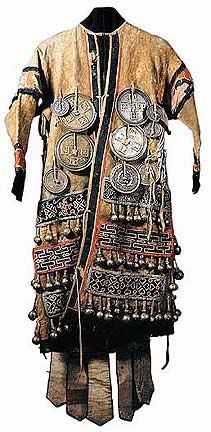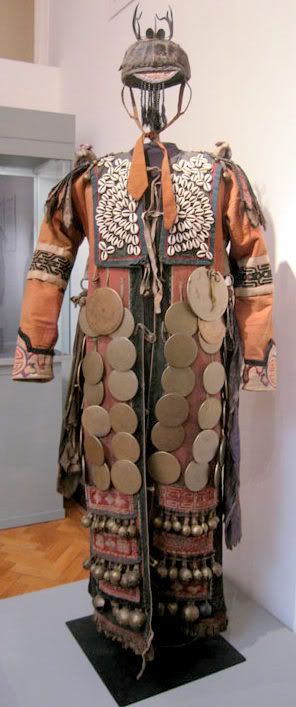|
|

CHINESE SHAMAN'S
EASTERN HAN TOLI MIRROR.
EASTERN HAN 25 - 220 A.D.
ORIGINAL Chinese bronze mirror
Diameter : 4.5 inches
* * * *
This mirror is very similar to the Bronze mirror with dragon and tiger motifs, Eastern Han dynasty, from M61 at the construction site of the former Guangzhou Cast Tube Factory, Xiwan Lu, Guangzhou - Hong Kong Museum of History.
Please note: This is a real Chinese Shaman's ancient mirror and not a new Chinese copy.
The mirror is 100% genuine and original as found.
The patina is magnificent.
The surface has expected weathering, wear, degradation and abrasions as a consequence of age.
-------------------------------------------
CHINESE BRONZE / SHAMAN MIRRORS.
Mirrors have been used in China since ancient times for both practical and spiritual purposes.
Thousands of examples of these early bronze mirrors have been excavated and these mirrors can be found in collections worldwide.
Bronze casting technology has been known in China since
at least 2750 B.C., which is the earliest known bronze object to date.
Bronze was a core component of the ancient Chinese world.
Bronze was cast to serve the principle affairs of the
state, both ritual and war.
Control of bronze objects not only meant control of the instruments of war, but also access to heaven since bronze was the principle material for ritual objects.
Ancient China had all the resources required to make bronze within their borders including copper, tin and lead ores.
There are over 800 copper ore deposits in China with most of them producing copper in ancient times.
Craftsmen used many different alloys for different types of objects showing they had very good control of alloy composition and a clear understanding of their different properties.
Chinese bronze shaman mirrors probably evolved out of circular reflecting disks associated with cultures to the north of the Shang and early Zhou states.
There are many undecorated disks that have been discovered in burial tombs placed both on top of and next to the deceased.
The
earliest decorated mirror is only 9 cm in diameter and has a
simple star decoration.
This simple Shaman mirror was discovered in a tomb in modern day Qinghai province and dates to the Xia Dynasty (2100-1600 B.C.)
By the Eastern Zhou era (771-256 B.C.), mirrors attained the
status of a unique object in the Chinese tradition with their form
and decoration becoming distinctive among the other bronze objects of
the period.
Chinese bronze shaman mirrors were initially produced in very
small numbers, but they were created in large numbers during the late Zhou and Han Dynasties.
To satisfy the demand for making these special mirrors foundries were built in the major capital cities.
Mirror production flourished from the Warring States period (475-206 B.C.) until the Tang dynasty (618- 906).
Most Chinese bronze / Shaman mirrors are round, but square and rectangular mirrors were also produced.
The back of these mirrors were decorated while the front of the mirrors were finely polished creating the reflective (mirror) surface.
The decorated side of the bronze mirror was full of symbolism especially in the
earlier dynasties.
The Chinese believed that by using symbols representing the universe, it would be possible
to acquire some of the universe’s power to gain both strength and protection from evil.
Round mirrors represent heaven, square mirrors represent the earth.
Cast inscriptions were added to the decoration of mirrors beginning around 200 B.C. during the Western Han period.
The inscriptions which are like incantations or prayers, were meant to attract supernatural powers and bring good fortune for the living or, if placed in tombs, to assist the dead by
keeping evil spirits away.
These Chinese bronzes mirrors could be held in the hand or grasped
by a cord passed through the pierced knob on the back (the lug).
The knobs / lugs are often simple domes, but they can be very decorative taking many different forms.
Cold pressure welding was an early technique used during the Zhou dynasty before amalgam
gilding was invented.
The bronze surface may have been prepared chemically, then the metal sheet was applied to the surface by careful preheating and then burnishing.
Mercury gilding with both silver and gold was used in
China by the late 4th century B.C.
The silver or gold was dissolved in boiling mercury and the resulting paste smeared on the surface of the mirror before being fired.
During the Tang Dynasty, the decorated side of some mirrors were made with gold or silver sheet. These are very rare mirrors and these mirrors were very small.
Very few of these mirrors were ever made due to the expense.
A few Chinese / Shaman mirrors were painted but very few remain intact and if original are very rare.
Chinese / shaman mirrors were valued for ritual purposes
associated with the power of reflection.
Chinese spirits, both good and bad, are supposed to throng the earth and plaque the living.
Chinese / shaman mirrors have the power to ward off evil since the form of any invisible spirit which will become visible when reflected in the mirror.
Taoist scholars are said to have worn a mirror hanging down their back so they could pursue their studies without fear of being harmed by the invisible spirits all around them.
Nothing was considered more powerful in warding off evil spirits than the threat of making them visible in the mirror.
It was not only the living who were protected by these Chinese / shaman mirrors, the dead were also protected.
In burial, mirrors were often placed face up on the breast of the deceased to protect them from evil spirits.
Mirrors were also buried along side their owners with food, drink and the other prized and necessary possessions to ensure a comfortable eternity.
Chinese / shaman mirrors have continued to be used over the years in China and they can still be found in private homes, on shop fronts and on public buildings as protection against evil spirits.
The composition of the bronze alloy to cast Chinese / shaman mirrors was very carefully chosen.
These mirrors are composed of about 70% copper, 25% tin and 5% lead.



Old Shamans Coat Mongolian Shamans Coat
The above pictures are of old (ancient) shaman's coats. These coats are an essential part of a real shaman's ancient traditions. These coats are made from a combination of silk and fur and on them hang glass beads, shells, bronze bells, pieces of blessed and empowered cloth, thogchags (Mongolian & Tibetan charms), and Bronze Shaman's mirrors (Toli & Melong). All of these items make up the Shaman's universe and are needed for his special ancient healing. These coats can be very heavy with all the bronze Toli and Melong (Mirrors) Thogchag (Mongolian and Tibetan Charms) and other sacred and blessed items. These coats are special healing articles and contain much of the sacred power that the Shaman will draw upon in his healing and magical work. By wearing coats such as these the Shaman is actually wearing and is always reminded of his special magical universe. The Shamans coat is part of his protective armour which protects him from hostile and very dangerous spirits while he shamanises and heals. The large Toli and Melong (Shamans mirrors) are hung on the coat to deflect the attack of hostile and dangerous spirits and also act as a home for the Shaman's own helper sacred spirits.
-------------------------------------------
Casting a bronze
mirror.
When casting a bronze shamans mirror
the first step was to make a clay mold in two parts and fuse them together. Each
part of the mold held a cavity into which smelted bronze was poured. Once the
bronze liquid cooled off and solidified, the outer clay was removed and the
mirror was finished off. The back of the shamans mirror was sometimes decorated
with patterns and inscriptions with a ring at the centre through which a khata
(a sacred blessed scarf) or rope could be strung. The mold for the front mirror
cavity was very smooth, and generally concave.
Materials in a bronze
mirror.
Bronze is a mixture of copper, lead
and tin, proportions of which varied throughout history. It was not standardized
until the Han Dynasty (206 BC- AD 220). The proportions were then fixed at 60-70
percent copper, 23-25 percent tin and 4-6 percent
lead.
Processing of a bronze
mirror.
After being cast the mirror was
polished with a mixture of azoth and tin powder. This process would be repeated
after the mirror had become dim from long use.
Shape of bronze
mirrors.
Most shamans bronze mirrors are
round, but they are also square, water chestnut flower-shaped, octagonal or in
the shape of bell.
Size of bronze
mirrors.
Ancient shamans bronze mirrors come in many different sizes. The smallest are 3 to 8 centimetres wide, and are usually worn as pendants from the neck or waist. Medium sized mirrors are 10 to 40 centimetres wide, and were hand held, standing, or hung on a wall. The largest were of 40 centimetres or more wide. In 1980 a 115-cm-long, 57-cm-wide giant bronze mirror was unearthed in Zibo, Shandong Province.
-------------------------------------------
It is very difficult if not impossible to find a real old shaman's mirror. Traditionally when a Mongolian Shaman died his mirror or mirrors would be buried with him. If they were not buried with him these sacred Toli mirrors are usually passed on generation to generation. Sometimes a Shaman might hunt a mirror by trying to find out where other Shamen were buried and then dig it up. Sometimes a Shaman’s mirror that had been buried would ‘speak’ to another as it would want to work with the living Shaman instead of staying with their deceased original owner. .
In ancient Mongolia a bronze mirror was a special sacred token, and a funeral object whose purpose was to signify a love that carried on into the afterworld. In ancient times it was believed that the soul lived on after death, but that as a person made their way to the netherworld they were forced to drink a potion that wiped out all memory of events in their lifetime. Devoted couples hence each held halves of a mirror at their funeral, so that on entering the afterworld they could meet, match their halves and resume their life together.
-------------------------------------------
The items on this Spiritual-Sky eBay site, call you to go back, far back in time to when you were a child. In those days you thought that nothing at all was impossible, you could do anything and everything. In those days long ago your spirit had not been reduced by negativity you believed in pure and special magical powers and your mind was open to receive and discover and to understand the mysteries of life.
--------------------------------------------
These Sacred Blessed and Empowered items have PURE POSITIVE SACRED POWER and can and will be attuned to you. Do you remember long ago that you had the ability of second sight, and other special abilities. You might never have revealed this to anyone as you felt slightly afraid and were not sure in yourself. Years later life takes its toll and you now think that these special abilities that you had years ago are now gone. These abilities NEVER GO, you still have the same abilities but you now have to clear a path to open your mind and be able to go back to your childhood and let your mind open up. When you work with our Sacred Blessed items you will soon realise that these are SACRED SPECIAL TOOLS and will work for you in many different ways. They will open up a PURE POWER FLOW FOR YOU, and enable PURE POSITIVE ENERGY to enter your divine spirit.
-------------------------------------------------------------
Shamanism is humanity's oldest form of relationship to the spirit world. As such, it is the underpinning beneath all religion. But shamanism is not a religion. It is a complex set of practices, beliefs, values and behaviors that enable the practicioner to elicit a shift from ordinary consciousness into a trance state with a specific goal in mind, such as for healing, obtaining information, power, vision, divination, contacting the spirit of the deceased, soul retrieval or guidance for right action. Shamanic work is done with the aid of a helping ally of some sorts that the shaman has befriended. They work together as a cooperative team, with the ally being an intermediary between different levels of reality and the shaman, an engineer of altering states of consciousness.
Shamans throughout the world and throughout time, recognize that the universe is alive, conscious, and filled with spiritual power. Shamans know how to access this web of power and work with it skillfully and effectively to address their, and their community's needs. Shamanism is the use of shamanic practices within a shamanic value system. Traditionally a shaman goes through the experience of a "calling", usually through illness, accident or some unusual quality of being, then through an arduous apprenticeship of teaching, training and testing, followed by some sort of passage rite into their new status. Typically shaman do not define themselves as such. Instead they are defined by their community based on what it is that they do. Becoming a shaman and living as a shaman is a difficult and demanding life path that many indigenous people shy away from because of its formidable requirements. It is not about fun and glamor. Unskillful and uneducated acts can cause harm, or even be life-threatening, to the practicioner as well as to others. For shamanism deals with power, and power can move in many different ways, like electricity. It is important to move slowly with respect, humility and care.

Our sacred, rare, empowered and blessed items are being made available for the benefit of practitioners, like you, who would like to have holy objects as devotional support to your practice. It is contrary to our vows to engage in the business of selling holy objects for profit. Therefore we do not provide these objects in an ordinary way, thinking of them as goods to be bought and sold. Rather, we are making them available with the express wish to benefit others. All funds in excess of our costs help us to continue our activities.


